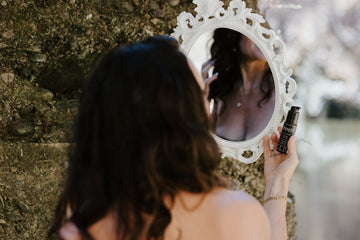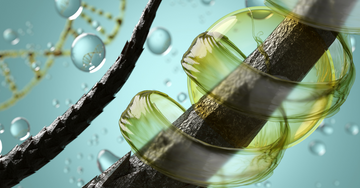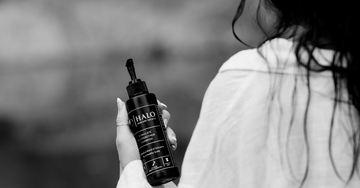Consider this: your hair natural composition is made up of around 90% protein. So, how likely is it that your hair is actually sensitive to it? Pause and think about that.
You’re Not Protein Sensitive
First things first, most people who believe they are protein sensitive may not actually be so. Protein sensitivity in hair is a misconception more often than not. The real issue might lie elsewhere, such as using the wrong type of protein, an imbalance between protein and moisture, not using them at the correct time in your routine, or not considering the pH of your hair products.
What is Protein?
Proteins are large, complex molecules that play many critical roles in the body. They are made up of smaller units called amino acids. In the context of hair, keratin is the primary protein that makes up your hair’s structure, giving it strength and resilience.
What Does Protein in Hair Products Do?
Proteins in hair products aim to repair and strengthen the hair shaft. When your hair is damaged, the protein fills in the gaps along the hair shaft, helping to rebuild and fortify your hair. This is especially important for chemically treated, heat-damaged hair, over brushing and environmental damage.
So, Why Do You Think You’re Protein Sensitive?
If your hair feels dry, stiff, or brittle after using protein treatments, it’s not necessarily because your hair is protein sensitive. It could be due to other factors, such as:
- The Protein in Your Product is the Wrong Size (Molecular Weight)
The molecular weight of the protein in your hair product matters. Smaller proteins can penetrate the hair shaft and repair damage from within, while larger proteins coat the hair and provide surface-level protection. Knowing your hair type and needs can help you choose the right protein treatment.
- You’re Not Following Up with a Moisture Conditioner
Protein treatments can make hair strong, but without a balance of moisture, your hair can become stiff and prone to breakage. Following up with a moisture-rich conditioner helps to restore elasticity and smoothness, creating a balanced and healthy hair environment. Think of protein as the building blocks and moisture as the glue that holds it together. This doesn’t mean you are sensitive to protein it just means your haircare routine isn’t balanced.
- The pH of Your Product is Too High
Hair products with a high pH can raise the hair cuticle, causing damage and reducing the effectiveness of the protein treatment. Ensuring your products have a balanced pH to your hair can help maintain hair health and optimize the benefits of protein treatments.
- You’re Not Clarifying Beforehand
Build-up from styling products, oils, and environmental pollutants can prevent protein treatments from penetrating the hair shaft. Using a clarifying shampoo before applying a protein treatment ensures your hair is free from build-up and ready to absorb the treatment effectively.
Your Hair’s Texture: Thin or Coarse?
The thickness of your hair plays a significant role in how it responds to protein treatments.
- Thin Hair: Thin or fine hair can be easily weighed down by heavy proteins. Lightweight proteins like silk or amino acids are more suitable as they penetrate the hair shaft without making it feel heavy.
- Coarse Hair: Coarse hair, on the other hand, benefits from heavier proteins like wheat protein, which help to fortify the hair and reduce frizz.
Understanding Hair Porosity and Protein Compatibility
Hair porosity refers to your hair’s ability to absorb and retain moisture. It’s a critical factor in determining the types of hair care products that will work best for you, especially when it comes to protein treatments. There are three main types of hair porosity: low, normal, and high. Let’s explore what they mean and which proteins suit each type.
Low Porosity Hair
Low porosity hair has tightly closed cuticles, making it difficult for moisture and products to penetrate. This type of hair tends to repel water and can feel resistant to treatments.
Best Proteins for Low Porosity Hair:
- Hydrolyzed Silk Protein: Lightweight and easily absorbed, providing moisture without weighing the hair down.
- Amino Acids: Small molecules that can penetrate the hair shaft, offering strength and elasticity.
Normal Porosity Hair
Normal porosity hair allows moisture to be absorbed and retained with relative ease. The cuticles are slightly raised, which balances absorption and retention.
Best Proteins for Normal Porosity Hair:
- Soy Protein: Strengthens and smooths the hair, maintaining its health and resilience.
- Wheat Protein: Offers balanced moisture and strength, perfect for maintaining healthy hair.
High Porosity Hair
High porosity hair has raised cuticles, which can lead to quick moisture absorption but also rapid moisture loss. This type of hair often feels dry, frizzy and prone to breakage.
Best Proteins for High Porosity Hair:
- Hydrolyzed Wheat Protein: Helps to fill in the gaps in the hair shaft, reducing porosity and enhancing moisture retention.
- Hydrolyzed Oat Protein: Adds strength and elasticity, helping to reduce breakage and improve texture.
Best proteins for internal damage:
Chemically treated hair needs internal support, amnio acids and silk protein are great choices which have a small molecular weight.
Best proteins for protection:
A damaged cuticle needs a shield to prevent further wear, wheat, lupin and oat are great choices to reduce frizz, prevent tangles due to their larger molecular weight.
Types of Proteins in Haircare and Their Best Uses
Understanding the different types of proteins found in hair care products can help you choose the right one for your hair’s specific needs. Here’s a breakdown of common proteins and their suitability for various hair types and porosities.
Hydrolyzed Keratin
Benefits: Repairs and strengthens damaged hair by filling in gaps along the hair shaft. It smooths the cuticle, reducing frizz and enhancing shine.
Best For: High porosity hair, normal porosity hair, thick hair.
Hydrolyzed Wheat Protein
Benefits: Improves the hair’s ability to retain moisture, adding volume and thickness.
Best For: High porosity hair, normal porosity hair, fine hair.
Find me in: Rejuvenate Dust and Reinforcement
Hydrolyzed Silk Protein
Benefits: Provides a light, protective barrier, increases elasticity to prevent breakage, while imparting a silky, shiny, smooth texture to the hair.
Best For: All porosity hair and hair types, very good for low porosity due to the small molecular weight it can easily penetrate, fine, high porosity hair or damaged hair to rebuild damage match with a larger protein to add a protective film.
Find me in: Hydrated Halo Pre-treat, Strengthen and Shine, Kinks, Curls and Coils, Rejuvenate Dust, Reinforcement and Tangled Toner
Soy Protein
Benefits: Increases moisture retention and adds a protective barrier to the hair.
Best For: Normal porosity hair, fine hair.
Find me in: Rejuvenate Dust and Reinforcement
Amino Acids
Benefits: Penetrate the hair shaft to repair and strengthen from within, enhancing elasticity and shine.
Best For: All porosity and hair types.
Find me in: Revitalise Serum
Rice Protein
Benefits: Enhances hair volume and strength, making hair look fuller and thicker.
Best For: Fine hair, normal to high porosity hair.
Oat Protein
Benefits: Provides moisture and conditioning, helping to smooth and soften the hair.
Best For: All hair types, particularly dry or damaged hair.
Find me in: Rejuvenate Dust and Reinforcement
Lupin Protein
Benefits: Improves hair elasticity and strength, protecting against breakage and damage.
Best For: High porosity hair, thick hair.
Find me in: Hydrated Halo
Try Heat Caps to Help Absorption of Protein Molecules
Heat can help open the hair cuticle, allowing protein treatments to penetrate more deeply. Using a heat cap or a shower cap during your protein treatment can enhance its effectiveness, making sure the proteins reach where they are needed most.
Conclusion
Understanding the science behind your hair and the products you use is crucial. In summary, your hair is likely not truly sensitive to protein. The key is understanding your hair's porosity and texture to select the right type of protein treatment. Whether you have low, normal, or high porosity hair, or fine or thick strands, choosing the appropriate hydrolyzed protein can transform your hair’s health and strength. Balancing protein with moisture and using products formulated for your specific needs will keep your hair resilient, elastic, and beautiful. Don’t fall for the myth of protein sensitivity—empower yourself with the knowledge to care for your hair effectively.





